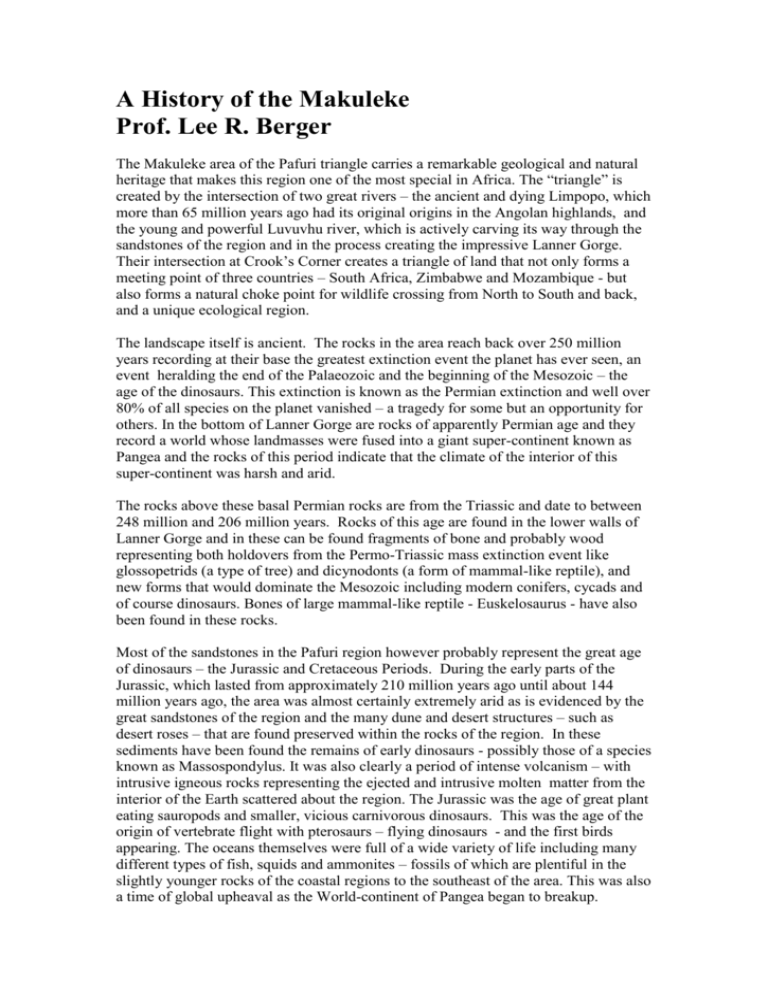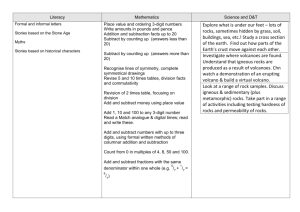A_History_of_the_Mak..
advertisement

A History of the Makuleke Prof. Lee R. Berger The Makuleke area of the Pafuri triangle carries a remarkable geological and natural heritage that makes this region one of the most special in Africa. The “triangle” is created by the intersection of two great rivers – the ancient and dying Limpopo, which more than 65 million years ago had its original origins in the Angolan highlands, and the young and powerful Luvuvhu river, which is actively carving its way through the sandstones of the region and in the process creating the impressive Lanner Gorge. Their intersection at Crook’s Corner creates a triangle of land that not only forms a meeting point of three countries – South Africa, Zimbabwe and Mozambique - but also forms a natural choke point for wildlife crossing from North to South and back, and a unique ecological region. The landscape itself is ancient. The rocks in the area reach back over 250 million years recording at their base the greatest extinction event the planet has ever seen, an event heralding the end of the Palaeozoic and the beginning of the Mesozoic – the age of the dinosaurs. This extinction is known as the Permian extinction and well over 80% of all species on the planet vanished – a tragedy for some but an opportunity for others. In the bottom of Lanner Gorge are rocks of apparently Permian age and they record a world whose landmasses were fused into a giant super-continent known as Pangea and the rocks of this period indicate that the climate of the interior of this super-continent was harsh and arid. The rocks above these basal Permian rocks are from the Triassic and date to between 248 million and 206 million years. Rocks of this age are found in the lower walls of Lanner Gorge and in these can be found fragments of bone and probably wood representing both holdovers from the Permo-Triassic mass extinction event like glossopetrids (a type of tree) and dicynodonts (a form of mammal-like reptile), and new forms that would dominate the Mesozoic including modern conifers, cycads and of course dinosaurs. Bones of large mammal-like reptile - Euskelosaurus - have also been found in these rocks. Most of the sandstones in the Pafuri region however probably represent the great age of dinosaurs – the Jurassic and Cretaceous Periods. During the early parts of the Jurassic, which lasted from approximately 210 million years ago until about 144 million years ago, the area was almost certainly extremely arid as is evidenced by the great sandstones of the region and the many dune and desert structures – such as desert roses – that are found preserved within the rocks of the region. In these sediments have been found the remains of early dinosaurs - possibly those of a species known as Massospondylus. It was also clearly a period of intense volcanism – with intrusive igneous rocks representing the ejected and intrusive molten matter from the interior of the Earth scattered about the region. The Jurassic was the age of great plant eating sauropods and smaller, vicious carnivorous dinosaurs. This was the age of the origin of vertebrate flight with pterosaurs – flying dinosaurs - and the first birds appearing. The oceans themselves were full of a wide variety of life including many different types of fish, squids and ammonites – fossils of which are plentiful in the slightly younger rocks of the coastal regions to the southeast of the area. This was also a time of global upheaval as the World-continent of Pangea began to breakup. The Jurassic gives way to the Cretaceous Period in the upper rocks of the Makuleke area, and these are particularly evident in the North and East of the Pafuri. In these upper-most rocks - the region still seems to be dominated by deserts but these seem to give way to water born gravels that may indicate the emergence of the ancient Limpopo in the region. This is particularly evident in areas like Matule hill, where abundant gravels contain large and small bone fragments that appear to be those of medium-sized and small dinosaurs. Fossil wood typical of the Cretaceous flora have also been found in the rocks of the region. The Cretaceous Period lasted from about 144 million years ago until 65 million years when it appears that a large extraterrestrial object striking the Earth in the Gulf of Mexico wiped out the dinosaurs. While the Cretaceous is often referred to as the end of the age of dinosaurs, many new and wonderful experiments appeared. This is the age of Tyrannosaurus rex and the ceratopsian dinosaurs (armoured and horned dinosaurs like triceratops). The abundant marine deposits of the North East coast of South Africa are of this age. There is also the hope of finding the rarest forms of vertebrates alive in this time period – the tiny mammals which would eventually dominate the planet after the Cretaceous extinction event. The Cretaceous is followed by the Palaeogene Epoch – but this is apparently not well recorded in this region. Rather we have to move down almost sixty three million years in time to just under two million years – where we find the Limpopo and Luvuvhu sands and gravels covering the lower parts of the region. The landscape you see today in the Makuleke has been carved out by the meanderings and erosional activities of the two rivers. The sandy soils that you walk on are sediments that have been brought from hundreds if not thousands of kilometers away by the Luvuvhu and the Limpopo. From about 1.5 million years ago, human ancestors, most probably members of the species Homo erectus, were attracted to the area as a source of raw material for making early stone age tools. Homo erectus were near humans – man apes with our stature but with brains only three-quarters our size. The raw materials they were seeking are still visible today in the form of rocks and cobbles of non-native materials brought from the West and in abundance in channel lag deposits left b the ancient Limpopo. Homo erectus clearly found this raw material provided by the rivers of great importance and used these abundant gravel deposits as quarry sites – there are quite literally hundreds of thousands if not millions of stone tools, and the byproducts of their manufacturing process, which can be seen throughout the area. Beautifully crafted handaxes – which are common – are evidence that this early stone tool culture represents the Acheulean industry and lasted from around 1.7 million years ago until around 250,000 years ago when it gave way to a slightly more advanced stone tool culture known as the Middle Stone age. The vast numbers of Acheulean aged stone tools in the region are not only testimony of the large numbers of human ancestors that occupied the area, but also the vast amount of time in which this occupation occurred – more than 1.4 million years of continuous occupation. Tools of the Middle Stone Age are also in abundance in the area, particularly on top of hills and mountains in the region where these humans were apparently using overlooks and high spots to scout for game. On top of many hills, at particularly good outlooks, can be found quite literally thousands of Middle Stone age knives, scrapers and spear-points. The Middle Stone Age begins around 250,000 years ago and ends around 25 – 35 thousand years ago. It holds within this temporal period not only the origins of a new and more complex toolkit used by humans, but the origin in Africa of modernity itself – it is during the middle part of this period that we see not only the emergence of the modern human brain and physical features but modern human culture – our infinite toolkit, artwork and burial of the dead. The Middle Stone age is followed in this region by the Latest Stone Age – and almost any place you stop will have evidence of the micro-lithic cultures that characterize this hunter-gather lifestyle of modern humans. The Latest Stone Age merges with the culture of Iron-aged Bantu speaking pastoralists who moved into the region around 2000 years ago. Rock art from this period is abundant in the region, particularly South of the Luvuvhu, but good examples have recently been discovered in the Pafuri region itself. From around 1200 a great cultural civilization and trade network began to emerge just to the North as is evidenced at such sites as Mapungubwe. Additionally, the idea of sacred leadership emerged – concept that transcends English terms such as “Kings” or “Queens”. Sacred leaders were elite members of the community, types of prophets, people with supernatural powers and the ability to predict the future. These early civilizations represented the rise of one of the greatest trade networks the world has ever seen. Through interactions and trade with Muslim traders plying the Indian ocean as far south as present day Mozambique – the region emerged as a trade center producing gold and ivory and trading for glass beads and porcelain from as far away as China. The end of Mapungubwe occurred at the same time as the rise of an even greater trading and architectural civilization – that of Great Zimbabwe – which flourished for more than one hundred years. The centre of power then shifted to the south at a site known as Khami near present day Bulawayo. It was then, around 1550, that groups crossed the Limpopo and founded numerous flourishing settlements in the Pafuri region including that of Thulamela on the southern bank of the Luvuvhu. Thulamela was one of many walled cities that existed in the Pafuri triangle – almost every hill and overlook in the area has evidence of significant occupation during this period. Thulamela and the other walled cities of the region were occupied at about the same time Portuguese trade began on the eastern coast of southern Africa. The wealth and sophistication of these people is evident by the beautifully crafted gold jewelry, Arab glass beads and Chinese porcelain found in the sites and accompanying burials of sacred leaders. The Thulamela culture ended around 1650. One may be surprised when visiting the modern Limpopo expecting the “great greygreen greasy Limpopo” of Kipling fame and yet seeing a great sand filled body instead. This is however, a recent phenomena probably due to a great extent to the over utilization by agriculture of the water resources of this great and ancient river. As recently as 1950, a Zambezi shark was caught at the confluence of the Luvuvhu and Limpopo rivers!






